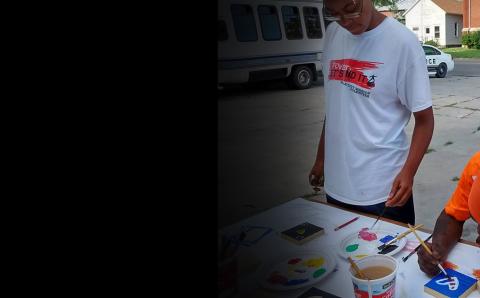You’ve probably seen huge piles of flattened boxes behind a mall or grocery store. Almost everything you buy comes in boxes that are sent to your town from a factory, warehouse, or farm. The food you eat, the clothes you wear, the books you read—almost all of it was shipped in boxes.
Because boxes are made from paper, and paper is made from trees, we need to figure out how to reuse and recycle all that cardboard. It’s an important part of taking care of God’s world.
How a Box Is Born
Most cardboard boxes start out as tall pine trees. After the tree is cut down, the bark is removed. Then the trunk gets chopped up into small pieces. Water and chemicals are added to break the pieces up into mush or “pulp.” The pulp is pressed to get the water out. When the pressed pulp is dry, it’s cardboard!
Find an empty cardboard shipping box and pull apart one of the flaps. You’ll see that the flap is made of three layers. One wavy layer of cardboard (called a “flute”) is glued between two flat layers (called “liners”). The wavy layer is what makes the box so strong.
If you want to see how cardboard is turned into boxes in a factory, check out a video at tinyurl.com/BannerBoxes.
Box Recycling Tips
Cardboard boxes very are easy to recycle. Just follow these simple steps.
- Take out anything that’s inside the box, including plastic or Styrofoam.
- Flatten the box.
- Keep the cardboard in a dry place until it’s time to recycle it. Wet cardboard can clog up sorting machines at recycling centers.
- Don’t recycle cardboard that has food or grease on it (like pizza boxes). That contaminates the recycling process.
Cardboard Houses
Last night you probably slept in a bed inside your house. But lots of people in our world slept outside because they don’t have a home. If it was cold, they struggled to stay warm. If it rained, they got wet.
In 2007, a woman named Tina Hovsepian decided that was not OK. She used folded cardboard to design a shelter that keeps people warm and dry in an emergency. She calls the shelters “Cardborigami.”
Now people in more than 90 countries can use Tina’s shelters if they’re homeless or if their homes are destroyed by bad weather. The people who make the shelters put a special coating on the outside to make them waterproof. To learn more about these cardboard houses, visit Cardborigami.org.
Did you know cardboard is strong enough to make furniture too? Check out these simple chairs!
Can you think of other ways somebody could use cardboard to help people?
Milk Carton Houses
You can turn a small milk carton like the kind you get at school into a perfect house for toy animals or LEGO® people. If you get milk at school, take a carton home and try it. Here’s how.
What you need
- Empty milk carton
- Patterned scrapbook paper or construction paper
- White glue
- Scissors
- Markers
What to do
Wash the milk carton and dry it well with paper towel. Then glue the flap closed (you can use a paperclip or clothespin to hold the edges of the top together after you put the glue on.) Use a scissors to cut a hole for a door. Then glue on scrapbook paper or other colored paper to decorate the milk carton. Use markers to add details like windows, signs, and other fun things. You could also make a whole town out of milk cartons, or glue a bunch of milk cartons together to make a castle.
Milk Carton Recycling
In Canada, milk cartons are recyclable almost everywhere. But in the United States, some cities have milk carton recycling and some don’t. Visit recyclecartons.com to find out if it’s available in your state. If it is, talk with your teacher or principal about recycling all those milk cartons at school!
Fun Facts
- Amazon ships more than 1,000 packages per minute. That’s more than a million boxes a day!
- Recycling one ton of cardboard saves about 17 trees.
- It takes about two months for a cardboard box to decompose (rot) in a landfill.
- Making recycled cardboard takes 25 percent less energy than making new cardboard.
- In 2016, a Dutch company named Smurfit Kappa set a new world record for the biggest cardboard box. It was 40 meters (131 feet) long, 20 meters (65.5 feet) wide, and 4 meters (13 feet) tall.
Box Books
The Cardboard Box Book
For more ideas for things you can make out of cardboard boxes, check out The Cardboard Box Book. You’ll find instructions for making a theater, a mailbox, giant dice, and more!
Box! Castles, Kitchens, and Other Cardboard Creations for Kids by Noel Macneal
This book has loads of crafts to make from cereal boxes, packing boxes, toilet paper rolls, and egg cartons.
What to Do with a Box by Jane Yolen
This is a fun book to read to a younger brother or sister.
About the Author
Sandy Swartzentruber serves as the resource coordinator for Faith Formation Ministries and is a member of Sherman Street CRC in Grand Rapids, Mich.









